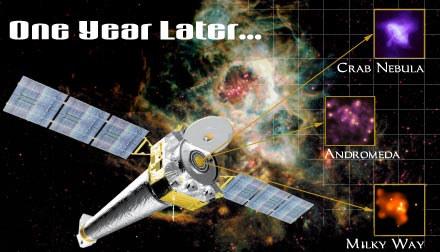Imagine the Universe News - 28 August 2000
X-RAY OBSERVATORY MARKS FIRST ANNIVERSARY
| 28 August 2000 |

|
| The world's most powerful X-ray telescope, NASA's Chandra X-ray Observatory, marks its first year in orbit with an impressive list of astronomy "firsts." |
NASA's Chandra X-ray Observatory celebrates its initial year in orbit with an impressive list of firsts. Through Chandra's unique X-ray vision, scientists have seen for the first time the full impact of a blast wave from an exploding star, a flare from a brown dwarf, and a small galaxy being cannibalized by a larger one.
Chandra is the third in NASA's family of great observatories, complementing the Hubble Space Telescope and the Compton Gamma Ray Observatory. "Our goal is to identify never-before-seen phenomena, whether they're new or millions of years old. All this leads to a better understanding of our universe, " said Martin Weisskopf, chief project scientist for the Chandra program at NASA's Marshall Space Flight Center, Huntsville, AL. "Indeed, Chandra has changed the way we look at the universe."
Chandra was launched in July 1999. After only two months in space, the observatory revealed a brilliant ring around the heart of the Crab Pulsar in the Crab Nebula � the remains of a stellar explosion � providing clues about how the nebula is energized by a pulsing neutron, or collapsed, star.
Chandra also detected a faint X-ray source in the Milky Way galaxy, which may be the long-sought X-ray emission from the known massive black hole at the galaxy's center. A black hole is a region of space with so much concentrated mass there is no way for a nearby object, even light, to escape its gravitational pull.
The observatory captured as well an image that revealed gas funneling into a massive black hole in the heart of a galaxy, two million light years from our own Milky Way, is much cooler than expected.
"Chandra is teaching us to expect the unexpected about all sorts of objects ranging from comets in our solar system and relatively nearby brown dwarfs to distant black holes billions of light years away," said Harvey Tananbaum, director of the Chandra X-ray Center in Cambridge, MA.
Perhaps one of Chandra's greatest contributions to X-ray astronomy is the resolution of the X-ray background, a glow throughout the universe whose source or sources are unknown. Astronomers are now pinpointing the various sources of the X-ray glow because Chandra has resolution eight times better than that of previous X-ray telescopes, and is able to detect sources more than 20 times fainter.
"The Chandra team had to develop technologies and processes never tried before," said Tony Lavoie, Chandra program manager at Marshall. "One example is that we built and validated a measurement system to make sure the huge cylindrical mirrors of the telescope were ground correctly and polished to the right shape." The polishing effort resulted in an ultra-smooth surface for all eight of Chandra's mirrors. If the state of Colorado were as smooth as the surface of Chandra's mirrors, Pike's Peak would be less than an inch tall.
"Chandra has experienced a great first year of discovery and we look forward to many more tantalizing science results as the mission continues," said Alan Bunner, program director, Structure and Evolution of the Universe, NASA Headquarters, Washington, DC.

